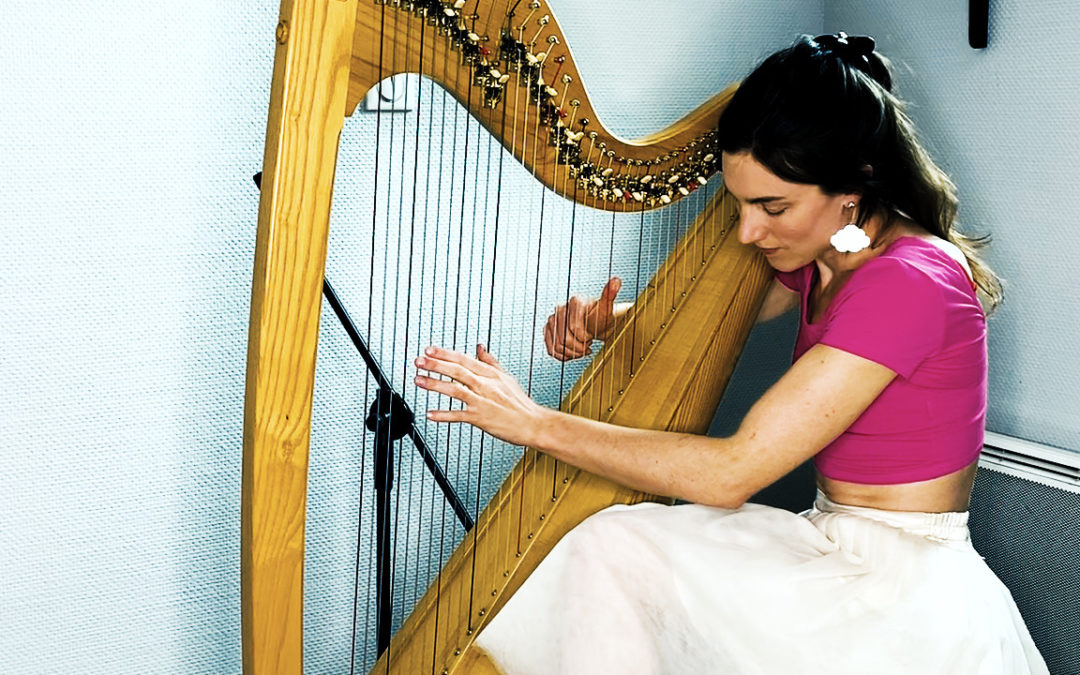Ahead of her livestreamed concert on 30 May, harpist Tamsin Dearnley reflects on her experiences moving between different musical traditions in Britain, France and Japan, and the extent to which music behaves like spoken language.
When we want to express something first heard or read in a language other than our own, we first need to have a reasonable understanding of both languages. Either we’re lucky enough to have been brought up in a multi-lingual environment, or we acquire our non-native languages at an older age.
Anyone who has had the latter experience (including myself – I learned French at school and read Japanese at university) knows that this is not an easy task, especially when the languages are extremely different from one another.
But what if there were a language that contained enough vocabulary in common all over the world that even a passing familiarity with the version from your home culture would enable you to understand – and even join in with conversations – with people from thousands of miles away speaking their own local dialect of the same language?
We are, of course, talking about that ubiquitous – and yet in so many ways slightly mysterious – cultural phenomenon that we call music.
There are so many similarities between the way we learn and transmit both music and spoken language that it’s very helpful to use a common set of vocabulary to describe the two. Music is often said to be a ‘universal language’, and it is true that as a conveyor of emotions you don’t have to have any familiarity with a particular musical culture to appreciate the pathos of an elegy, or to want to get up and dance to a jig or relentless drum rhythm.
But what happens when you want to ‘translate’ music from one particular culture into another? What happens when (as in my own case) one is essentially ‘mono-instrumental’ – and yet you want to learn and express musical ideas from other cultures that you find appealing or inspiring?
Photo credit: Trevor Fountain
Much of traditional musical culture develops around the instruments (and thus the materials and technology) available to a particular people at a particular time. In a pre-iron age world, instruments (other than the human body itself) were made largely of bones, skins and wood. Over time, different areas developed their own instruments, which in turn lent their music a distinctive sound, timbre, or even tonality. The fundamental physical properties of sound and the human body, however, ensure that all known musical cultures make use of certain intervals and rhythms (the octave, the fourth and the fifth, for example, and the simple 1-2, 1-2 rhythm of human gait), thus ensuring that we all have a certain amount of musical grammar and vocabulary in common.
As a Yorkshire-born musician who studied in Edinburgh, taught at a harp school in Tokyo and is now based in Toulouse, I perform and teach in English, French and Japanese. I grew up playing the lever harp and singing in choirs, and I find that my ‘native languages’ of British folk music and English choral music colour the way I play today. I’ll find myself adding ‘Scottishisms’ in my ornamentation of Japanese pieces, or using more plagal cadences than are perhaps fashionable in the twenty-first century.
Equally, however, I’m fascinated by just how literal a translation of a particular piece one can make. I don’t really play, for example, the Japanese koto – but a harp is similar enough that if I imitate certain techniques I can imitate the sound of this instrument, and in doing so discover ways of using my harp that I had simply never envisaged!
The techniques gained from this process of ‘translation’ I then add to my own musical vocabulary, ready to be brought out in my next arrangement of, say, a medieval European melody. It’s a continuous process of vocabulary learning and absorption, until there comes a point after which one simply uses the technique that best expresses what one wants to say, rather than thinking in terms of ‘this comes from this language’ – which is perhaps the essence of translingualism.
As a musician and linguist, I find so many parallels between the two areas. I think in terms of ‘expanding my vocabulary’ and ‘understanding the grammar’ of a particular musical language. My early explorations into jazz, for example, were hampered partly due to the physical limitations of my instrument, but also by the fact that my knowledge of jazz vocabulary and grammar was still very poor. As so often happens in foreign languages, I knew enough to understand what I heard, but not enough to engage in conversation. However, as I continue to study as many musical ‘dialects’ as possible, I find that I get better at expressing different genres, and I’m now including more pop and rock influences in my work.
During my online concert and presentation on 30 May, I’ll be exploring the ways in which I translate musical elements from a wide range of cultures onto the lever harp. How DOES one note bend on an instrument that really isn’t designed for this (yet)? How can one sound like a double bass to give jazz pieces a bit of extra oomph? And is it really possible to ‘sing’ the harp, as one does in Welsh? Tune in on the 30th to find out!
Tamsin Dearnley is a harpist, composer and sound designer with a focus on bringing the lever harp to a wider audience. She will be playing live on Saturday 30 May at 7pm BST – further details here. Booking is not necessary, but by doing so you will be sent a reminder containing the livestream link nearer the time.




This is fascinating,Tamsin, I learnt so much and the videos expressed it so well. Thank you.
Thank you so much – really glad you enjoyed it. Hope you can join us on Saturday!
Looking forward to your concert Tamsin. A fascinating insight. The harp is for me a golden thread opening up awareness and better understanding of so many genres
Thank you – fantastic that you can join us for the concert!
Tam, the link isn’t working
Hi, we’re currently having a problem with the IMLR site, but here’s the YouTube link: https://www.youtube.com/watch?v=a3yZCXk2tkc